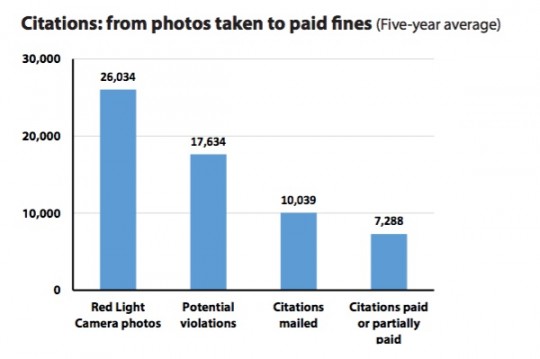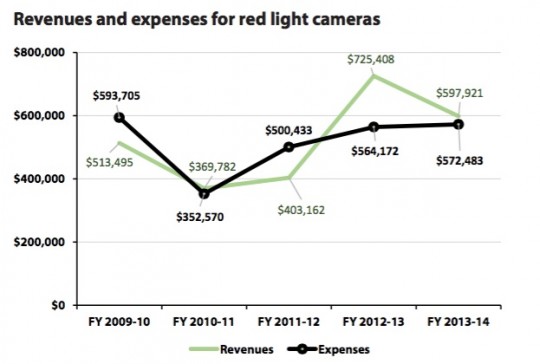With the Governor’s ink barely dry on a new law that gives Portland the authority to crack down on speeders with photo radar cameras, now is a perfect time for the City to re-assess its existing efforts in a similar front: red light cameras.
This morning the Audit Services Division released a report on Portland’s 11 red light cameras currently in use. Overall, the audit found that the red light camera program is working; but has lots of room for improvement.
Here are our five takeaways:
They appear to be working
Data from PBOT shows that the average annual number of crashes at locations where cameras are in use has declined compared to before the cameras were installed, even as more people drove through the intersections. The locations with cameras averaged 0.75 before they were installed and 0.42 after, a 44 percent decline. The auditor’s report did say, however, that those stats might be misleading because it’s not possible to know what other factors might have caused the decline.
Only about one-third of the photos result in a citation
The audit found that over a five-year period, only 39 percent of photos resulted in a citation. In cases where a citation was mailed, 75 percent resulted in some sort of payment. Put another way, just 28 percent of the people who were photographed by the cameras ended up paying a fine.
There are several reasons photos might not result in a citation and/or fine. They include: an unclear image where the driver’s identity cannot be confirmed, camera/equipment malfunction, or an unclear license plate number.
Pointing fingers about five cameras that got away
The audit uncovered a bit of intrigue between PBOT and the Police around the fate of five additional red light cameras that were supposed to be installed in 2011; but were instead sold to another city. The Police and the camera vendor say the cameras never got installed because PBOT couldn’t decide where to put them. PBOT’s side of the story is “more complex, and varies depending on the source,” the audit says. Some sources told the Auditor’s office that staff turnover at the Police bureau was to blame.
And here’s thing that really caught my eye: Transportation bureau sources said another reason the cameras never got installed was because they felt pressure to focus on street maintenance rather than safety.
Advertisement
Stronger collaboration needed between PBOT and the Police Bureau
With more red light cameras coming and new legislation that allows PBOT to install fixed-speed cameras on High Crash Corridors, coordination between the two bureaus responsible for engineering and enforcement must be stronger and more productive. Or, as the Auditor put it, “This ambitious plan will require a level of coordination between Police and Transportation that we did not find evidence of while conducting this audit.”
Red light cameras are not a cash cow
Far from it actually. According to the audit, the City’s red light camera program has operated at a loss in two of the five years studied. The starting fine for a red light camera citation is $260. Once the fee is reduced (which happens in 90 percent of cases when a case is brought to court) and the state, the camera vendor, and the court takes their share, the city makes very little.
In the City’s best year (FY 2012-2013) revenues were $725,408 and total expenses were $564,172, and revenue per citation was $16.84. But in 2011-12, when revenues were only $403,162 and expenses were $500,433, each citation cost the City $12.55.
——
With City Council’s recent adoption of a Vision Zero resolution and PBOT’s recent legislative victory on speed cameras, this audit comes at a very important time. Luckily, our current police chief used to head the the Traffic Division and seems to already be saying the right things. In a written response to the audit, Chief Larry O’Dea III committed to more frequent meetings with PBOT staff and he even mentioned Vision Zero.
— Red Light Cameras: City can fine tune some program aspects and solidify plans for future










Thanks for reading.
BikePortland has served this community with independent community journalism since 2005. We rely on subscriptions from readers like you to survive. Your financial support is vital in keeping this valuable resource alive and well.
Please subscribe today to strengthen and expand our work.
You only have to look at how the cameras work in Beaverton to see they work as required. They calm the traffic in the immediate area. A prime example is the camera at Lombard and Allen. Everyone drives very carefully in that area.
But go one stop light east at Allen and King, and every red light cycle sees cars running the red on Allen.
All you will get are pockets of more aware drivers and not an overall improvement. You just move the problem somewhere else.
I’m missing how reducing a city-wide problem in one location equates to moving it to other locations. Are you saying those other intersections had no issues before red light cameras were installed nearby? and, how do you know?
These camera’s are not put in place for a city wide problem, they target a specific area. By doing such they resolve a problem in the specific area, but don’t resolve the city wide issue.
That’s why traffic patrols are better, they can be anywhere at anytime. Move towards zero tolerance with lights and a stopped car and you’ll see better city wide compliance rather than location based compliance due to cameras.
How do you know?
How does he know what?
Was red light running a citywide problem? I don’t recall it being so. Hence, he’s right to disagree with you about a citywide problem being reduced in one area.
I think what you were trying to do is rhetorically ask him what the problem is with reducing the number of red light runners at a single intersection as that seems to be a good thing no matter if the problem shifts to another location.
“You only have to look at how the cameras work in Beaverton to see they work as required. …” canuck
In Beaverton, another location with red light cameras is the Beaverton Hillsdale Hwy/Griffith Parkway intersection (south of the Beaverton Town Sq shopping complex, between Lombard and Hwy 217.).
I think the red light cameras may be helping to discourage people from running red lights at this intersection, but whether the city has statistics verifying a reduction ‘pre-camera/post camera installation’, I don’t know. The two major intersections immediately east and west of this intersection also are signaled, but I don’t believe they have red light cameras.
I walk all three intersections during the day periodically, and don’t recall people running red lights during that time. In the evening at the Beav-Hillsdale Hwy-Griffith Parkway, is when from the coffee shop a short distance away, the camera flash can be noticed going off rather dramatically.
“they felt pressure to focus on street maintenance rather than safety.”
That’s very telling. Perhaps they felt pressure from the car-heads and, like always, the concerns of the car-heads was prioritized, rather than safety.
Yes would like the answers to more “why’s,”.
Why are citations only issued in 39% of cases? Surely they should be issued in 100%. A red light is a red light. Am I missing something?
Secondly, why are only 75% of citations paid, and what are the consequences for not paying?
There are several filters that must be passed before potential citations are forwarded to the Police for review.
The vehicle operator has to be visible. Oregon law issues moving violations to the vehicle operator, not the owner.
The vehicle license plate has to be visible.
If the vehicle operator does not match the gender of the vehicle owner – who do you send the ticket to?
If you send the ticket to the vehicle owner and request them to identify the driver, how do you compel that action?
In some states the citation is a simple fine that always goes to the vehicle owner, like a parking ticket, but is also usually a lower fine amount.
I’m more interested in how much judges reduce photo enforcement fines when someone shows up in court.
Vision Zero includes better laws and better adjudication.
God, I hope they’re not using facial recognition software, how creepy.
Some surveillance things are indeed creepy (the NSA being just the most obvious). But if this particular bit of technology creeps you out there is an easy way to avoid it: don’t speed/run a red light.
I know someone who works in a red light camera program in a Calif city. I believe in Calif you have to ID the driver of the car since the ticket goes to the driver not the car. If they can’t get a positive ID on the driver via the photo and or video then they can’t issue a ticket. They also have to review the photo and or video to make sure a violation happened. For example I know someone who stopped for the red light but the front of their car was past the limit line which triggered a photo. This was a violation of the law but not technically a red light violation thus no ticket due to running the red light.
As for why only 75% of tickets are paid that might be due to people going to court to fight their tickets.I know my friend spends a good amount of time in court or getting ready for court since a lot of people fight their tickets
A bit OT, but I watched a delivery truck run a red light at N Interstate and Tillamook today right in front of a PPB traffic patrol officer on a motorcycle and the officer ignored the violation.
Ahead of the officer or to the side? If the officer cannot see the signal, he has no way of knowing a violation occurred.
That’s funny. I got a $260 ticket for something the officer admitted he didn’t see. But the guy he saw run the red light said he did it because he wanted to catch up with me.
I would like to know how much the red light camera vendor “skims” off the top for their indispensable service.
Jonathan,
Respectfully, I think you’re looking at the revenue graph wrong.
Consider:
The large reduction in crashes would be great news, even if it came at an expense to the city. However, according to the audit, the City’s red light camera program has actually earned revenue in three of the five years studied! In the other two years it nearly broke even. This is highly encouraging news. It would be prudent to study whether this can be scaled to many more lights around the city at minimal cost (or even, perhaps, with net income!) to the taxpayers.
Also, those are only up-front figures for expense/revenue, and don’t consider the public cost-savings resulting from the 44-percent decline in crashes – or – 44 % increase in safety (courts & DA time, police response, street cleanup, liability, uninsured medical transport & hospital care, administration, etc.).
I think Jonathan’s point is at least in part a reaction to the common (mis-)perception that these cameras are part of a sinister plot to soak the poor, helpless, tricked car-bound lawbreakers.
That intersection is HORRIBLE, especially in the early morning (5-7a). People blow it continuously.
I would LOVE, LOVE, LOVE to see a red light camera at either Lombard and Interstate or Lombard and Denver.
I’d trade you for a speed Camera on Denver. I bet you 90% of people who run the red at Lombard are speeding when they get to Russet/Farragut/Terry.
PBOT does not install red light enforcement cameras based on violations, as the vendor suggested, but based on crashes in which violation of the red light was a factor.
Vision Zero is about the safety, not the revenue.
“Vision Zero is about the safety, not the revenue.”
So far it seems like Vision Zero (at least around these parts) is about the studies, the logo, the photo ops.
over one year later…
“The starting fine for a red light camera citation is $260. Once the fee is reduced (which happens in 90 percent of cases when a case is brought to court)”
Why are the fines being reduced – in most cases where the driver is guilty the fine should be increased to help pay for the cost of the courts time that they wasted with their entitled to drive however I want attitude.
It’s usually done at the discretion of the officer representing PPB in court, and it’s highly variable from officer to officer, based on a day I spent in court contesting a speed camera van ticket.
Car-head.
When I lived in Australia, they had red light cameras and speed cameras all over the place. The enabling legislation (they only have state police, not city police) was changed to put the onus on the registered owner of the vehicle to pay the fine and have the points deducted from their license, or identify the name and address of the driver. If the vehicle was registered to a corporate entity, the company either identified the driver or paid a fine that was triple the fine levied against an individual. I got one ticket when driving a company car, they told me I could give them a check or they’d take it out of my paycheck.
The system worked okay there, lots of people hate it, but it gets drivers following the road code.
What I like about the cameras is that they potentially catch all offenders, and there is no police officer discretion about issuing a citation. If the offender wants to argue, they either write to the issuing agency, or turn up to court and the judge can make the decision.
Nice. A law with teeth, sharp teeth! Why can’t we have that here?
“We’ve identified your gun as the murder weapon.”
“But it wasn’t me, must have been somebody else using it.”
“Oh okay then, never mind. Here’s your gun back.”
I think another reason that citations are not mailed is the lack of a front license plate. Speed cameras take both front and rear car photos, but I think red light cameras here take only a front photo. I may be wrong being someone who takes all traffic signals seriously in all modes of transportation.
I hope I live long enough to see people help responsible for their vehicles…
these lax laws just encourage motorists to wear ski masks to avoid responsibility… wear a ski mask and no more automated tickets or citizen citations…
why have these loopholes not been closed? when will they be closed?